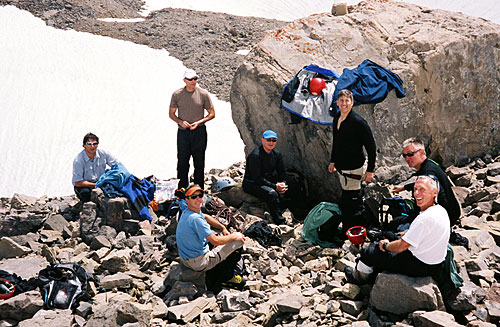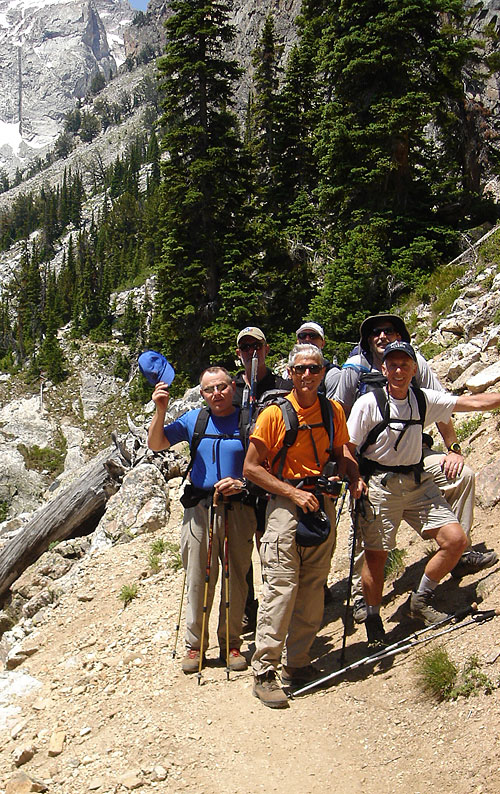
|
The group learns to rope up. Pictured from left to right are Christian Santelices, Richard Henderson (standing), Mark Newcomb, Harry Wallfisch, Jim Galbraith, Tom Kimbrough and Brent Masel. The Climbers The group was the same that summitted on Kilimanjaro in January 2002. See Climbing Kilimanjaro. It includes Galbraith, 51, and me, 55, and four other good friends: • Harry Wallfisch, 57, an anesthesiologist and long-time faculty member at UTMB. Harry is the group's compulsive worrier, slowest walker and quickest wit. • Brent Masel, 57, neurologist by training and executive director of the Transitional Learning Center in Galveston, a residential treatment program for people with brain injuries. Brent may be the bravest man in the group. These trips involve, for him, overcoming a fear of heights and months of tense negotiations with his wife. • Tom Kimbrough, 54, is a long-time surgeon at UTMB. Tom's a big man and strong as a bull, but on Kilimanjaro, we learned that old knee injuries made walking downhill unusually hard on him. Tom might actually prefer watching birds to climbing mountains. • Richard Henderson, 49, the youngest of our group, is a well-known Galveston veterinarian. He is quiet, has a dry wit, and when we're walking a trail he will be the first to spot some tiny animal.
Interesting note: Our wives and women in general seem obsessed with the dynamics of this group. When we call home, they ask, “Are you all getting along?” After the Africa trip, we returned much better friends than we had been before leaving. We have widely varying differences in style, background, politics and religion. Still, this group of six just works. We don't ask why. From the plane, we got our first glimpse of the Tetons. There's a word to describe them - scary. The Teton Mountains are an active fault-block mountain front 40 miles long and 7-9 miles wide. The range includes 12 peaks over 12,000 feet high, and the highest is The Grand Teton, 13,770 feet. The Tetons began rising roughly 8 million years ago. The mountains have gained 8,000 feet over the past two million years, five inches per century. In the last ice age, the valley and the mountains were gouged and rearranged by sheet ice 3,000 feet thick. The Tetons are among the most dramatic of all mountains in the United States - treeless, jagged shark teeth on the horizon. Later on July 4 at lunch in Jackson, our waiter regaled us with a story about a climber who had died in a fall the week before. “What I heard was that she just failed to tie one of her knots right when she was roping up,” he said. Knot tying was one of many aspects of the trip I had ignored. Galbraith and the others practiced bowlines and figure eights on the plane, but I had not even thought about that aspect of the climb. Now, it seemed more relevant. We had a good dinner that night and retired to our rented condo. The deck overlooked the Jackson Fourth of July fireworks extravaganza. We turned in just after the last, golden explosion. |
By Dolph Tillotson
Climbing Teton
1 - Just Have Fun
2 - The Climbers
3 - Tuesday
4 - Wednesday
5 - Thursday
6 - Friday
7 - Summit Day 8 - Time is Short The relationships are more important than the climb. Resources See also |
© 2005 The Galveston County Daily News. All rights reserved. A Galveston Newspapers Inc. Publication. |


